Due to the nature of its construction the wheel can, if not carefully treated, crack or shatter during use. To reduce the dangers of flying particles causing injury the wheel must be guarded with only the work area exposed. Examine the wheel frequently for cracks or other defects.
When grinding, move the work from side to side to avoid cutting grooves in the wheel. Use the front of the wheel as much as possible. If the side of the wheel is used, avoid using too much force.
Vitrified bond wheels can be checked with a procedure called the ring test:
The abrasive wheel or grinding wheel consists of two constituents:
The specification of a grinding wheel gives a clue as to its construction and suitability for a particular operation. For example a wheel carrying the marking:
38A60-J5VBE
would indicate that the wheel has an aluminium oxide abrasive; that the abrasive grit is medium to fine in grain size; that the grade is soft; that the structure shows medium spacing; that a vitrified bond is used. How the code marked on the wheel can indicate all this information required in selecting the correct wheel for a particular job will now be examined in some detail.
Manufacturer’s Type Code |
BS Code |
Abrasive |
Application |
- |
A |
Aluminium oxide |
A high strength abrasive for hard, tough materials |
32 |
A |
Aluminium oxide |
Cool; fast cutting, for rapid stock removal |
38 |
A |
Aluminium oxide |
Light grinding of very hard steels |
19 |
A |
Aluminium oxide |
A milder abrasive than 38A used for cylindrical grinding |
37 |
C |
Silicon carbide |
For hard, brittle materials of high density such as cast iron |
39 |
C |
Silicon carbide (green) |
For hard, brittle materials such as tungsten carbide |
Table 1 - Manufacturer's Type Code
This indicates the strength of the bond and therefore the 'hardness' of the wheel. In a hard wheel the bond is strong and securely anchors the grid in place and therefore reduces the rate of wear. In a soft wheel the bond is weak and the grit is easily detached resulting in a high rate of wear.
The bond must be carefully related to the use of the wheel. If it is too hard the wheel will glaze and become blunt, if it is too soft it will wear away too quickly. This would be uneconomical and also cause loss of accuracy.
Very Soft |
Soft |
Medium |
Hard |
Very Hard |
EFG |
HIJK |
LMNO |
PQRS |
TUWZ |
Table 2 – Grade
The correct selection of a grinding wheel depends upon many factors.
(a) An aluminium oxide abrasive should be used on materials with a high tensile strength.
(b) A silicon carbide abrasive should be used on materials with a low tensile strength.
(c) A fine grain wheel can be used on hard brittle materials.
(d) A coarser grain wheel should be used on soft ductile materials. (e) Grade. Use a hard wheel for soft materials and a soft wheel for hard materials.
(f) Structure. A close structured wheel can be used on hard, brittle materials. An open structured wheel should be used on soft, ductile materials.
(g) The bond is seldom influenced by the material being ground.
(a) Figure 1 shows what is meant by 'arc of contact'.
(b) Grain size. For a small arc of contact a fine grain can be used. For a large arc of contact a coarse grain should be used.
(c) Grade. For a small arc of contact a 'hard' wheel can be used. For a large arc of contact a 'soft' wheel should be used.
(d) Structure. For a small arc of contact a close grained wheel can be used. For a large arc of contact an open structured wheel should be used.
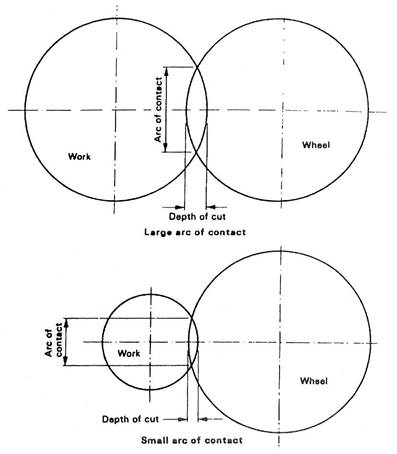
Figure 1 - Arc of Contact
A heavy, rigidly constructed machine can produce accurate work using softer grade wheels. This reduces the possibility of 'burning' the workpiece.
As well as being used for tool sharpening and precision grinding, the abrasive wheel is also used for the following processes:
(a) Dressing the weld and grinding the weld bead flush.
(b) Edge preparation.
(c) Cutting off awkward sections.
Abrasive wheels used for these purposes are subject to far more abuse than those used for precision grinding. They are also required to remove metal more quickly, but they do not have to leave such a good finish or work so accurately as precision grinding wheels.
A suitable cutting-off wheel for mild steel would be:
A 24 Q 8 B or R
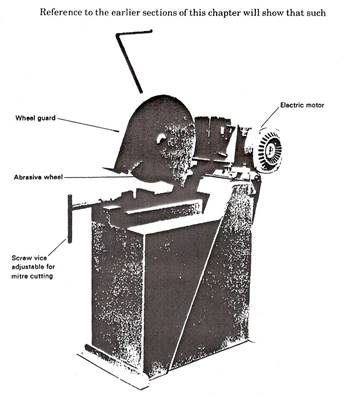
Figure 2 - Abrasive Wheel Cutting-Off Machine
A typical abrasive wheel cutting-off machine is illustrated in Figure 2.
These machines are driven by high power electric motors, the abrasive wheel revolving at speeds in excess of 3000 rev/min.
An adjustable stop is fitted to the counterbalanced head to compensate for wheel wear. A 'vee' belt drives the cutting head from the motor. The diameter of the abrasive wheel is generally about 400 mm and its thickness approximately 3 mm. The section to be cut is clamped in a screw vice, which has a swivelling back-plate for mitre cutting. The head is brought down by hand to sever the material. The high-speed abrasive wheel cuts through steel sections like a knife cutting through butter. Table shows typical cutting speeds.
Material Section |
Cutting Time |
||
Tube |
1 |
38 O.D. |
2.5 |
Angle |
3 x 3 x |
76 x 76 x 6.35 |
5 |
R.S.J. |
3 x 1 |
76 x 38 x 4.76 |
5 |
Flat bar |
2 |
57.2 x 9.53 |
2 |
Round bar |
1 Diameter |
25.4 Diameter |
2.5 |
Channel |
4 x 2 x |
101.6 x 50.8 x 6.35 |
9 |
Table 3 - Typical Cutting Times (Abrasive Cutting-Off Machine)
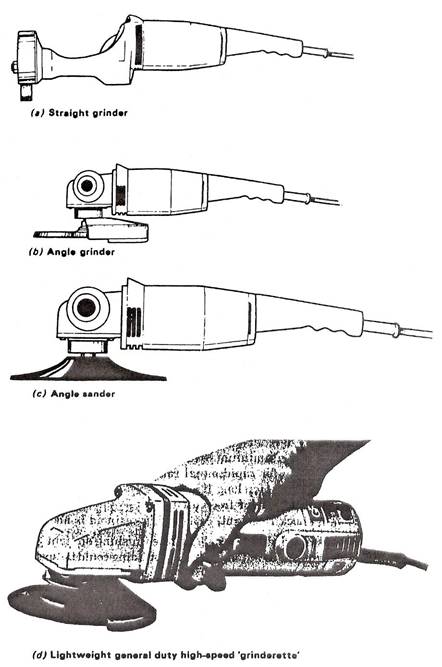
Figure 3 - Portable Electric Grinding Machines
Portable grinding machines are often used for smoothing down welded joints and seams and generally do much of the fabrication workshop jobs which would otherwise be done by the laborious methods of chiselling and filing.
These portable tools are basically of two types, ELECTRIC and PNEUMATIC, and the three most commonly used variations of portable grinders are:
Figure 3 and Figure 4 illustrates electrically-powered portable grinders. Figure 3(a) shows a 'straight' portable grinder. This uses an ordinary grinding wheel, cutting on its periphery as in tool grinding.
Usually two sizes are available:
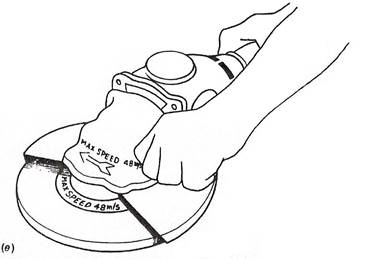
Figure 4 - Portable Electric Grinding Machines (continued)
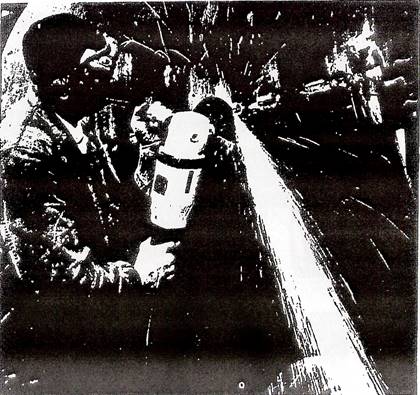
Figure 5 – (a) Grinding Welds with Angle Grinder
Hand-powered tools with exposed rotating heads must be switched off and have stopped revolving before being laid down. Otherwise, they can spin themselves off scaffolding, for instance, causing damage and injury.
Power grinders and cutting-off wheels must have guards for protection and to prevent oversize wheels being used.
ALWAYS USE THE CORRECT SIZE AND TYPE OF WHEEL FOR THE JOB - if it is too hard or too fine it becomes glazed. The operator must then use excessive pressure resulting in more breakages and reduced productivity.
Pneumatic grinders must have a mechanical governor to prevent the spindle exceeding its maximum speed.
Source: http://local.ecollege.ie/Content/APPRENTICE/liu/metalfab_notes/Grinding_M1_U11.doc
Web site to visit: http://local.ecollege.ie
Author of the text: indicated on the source document of the above text
If you are the author of the text above and you not agree to share your knowledge for teaching, research, scholarship (for fair use as indicated in the United States copyrigh low) please send us an e-mail and we will remove your text quickly. Fair use is a limitation and exception to the exclusive right granted by copyright law to the author of a creative work. In United States copyright law, fair use is a doctrine that permits limited use of copyrighted material without acquiring permission from the rights holders. Examples of fair use include commentary, search engines, criticism, news reporting, research, teaching, library archiving and scholarship. It provides for the legal, unlicensed citation or incorporation of copyrighted material in another author's work under a four-factor balancing test. (source: http://en.wikipedia.org/wiki/Fair_use)
The information of medicine and health contained in the site are of a general nature and purpose which is purely informative and for this reason may not replace in any case, the council of a doctor or a qualified entity legally to the profession.
The texts are the property of their respective authors and we thank them for giving us the opportunity to share for free to students, teachers and users of the Web their texts will used only for illustrative educational and scientific purposes only.
All the information in our site are given for nonprofit educational purposes